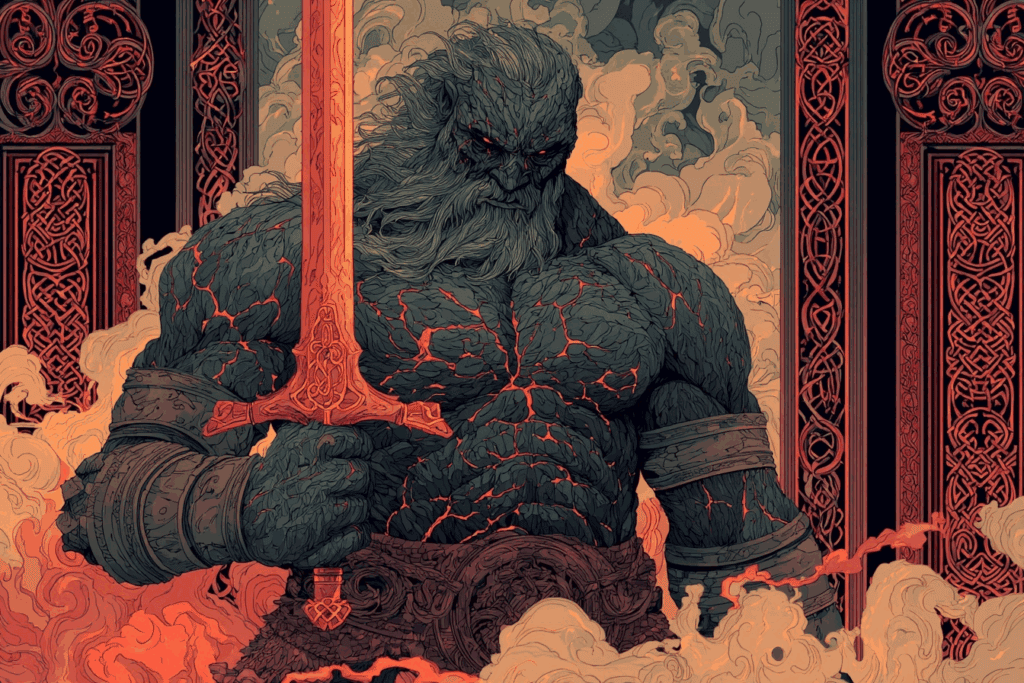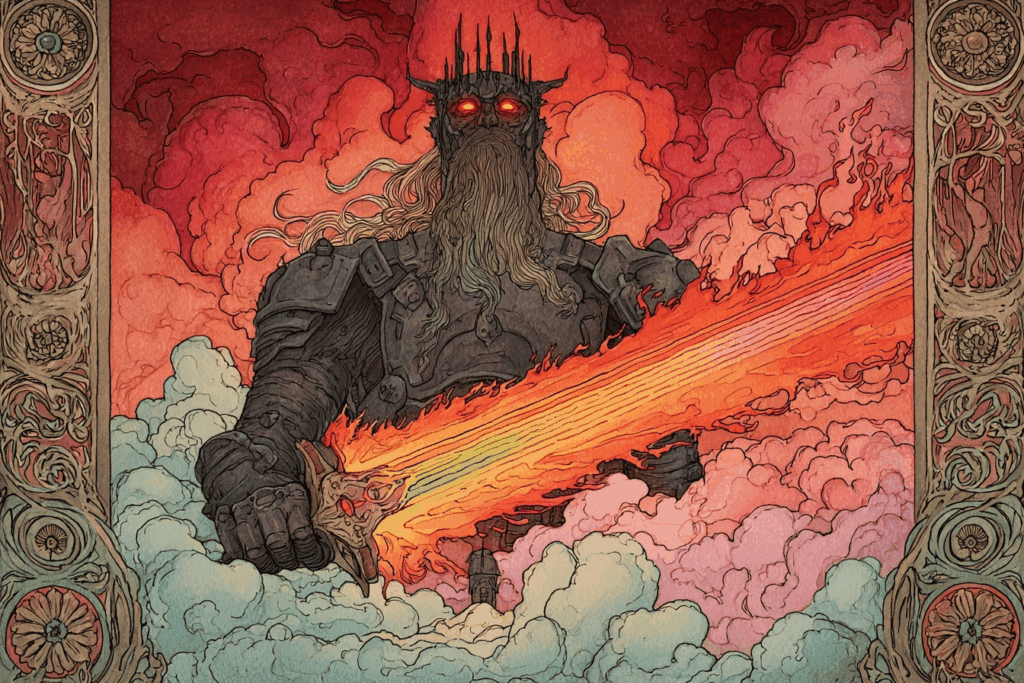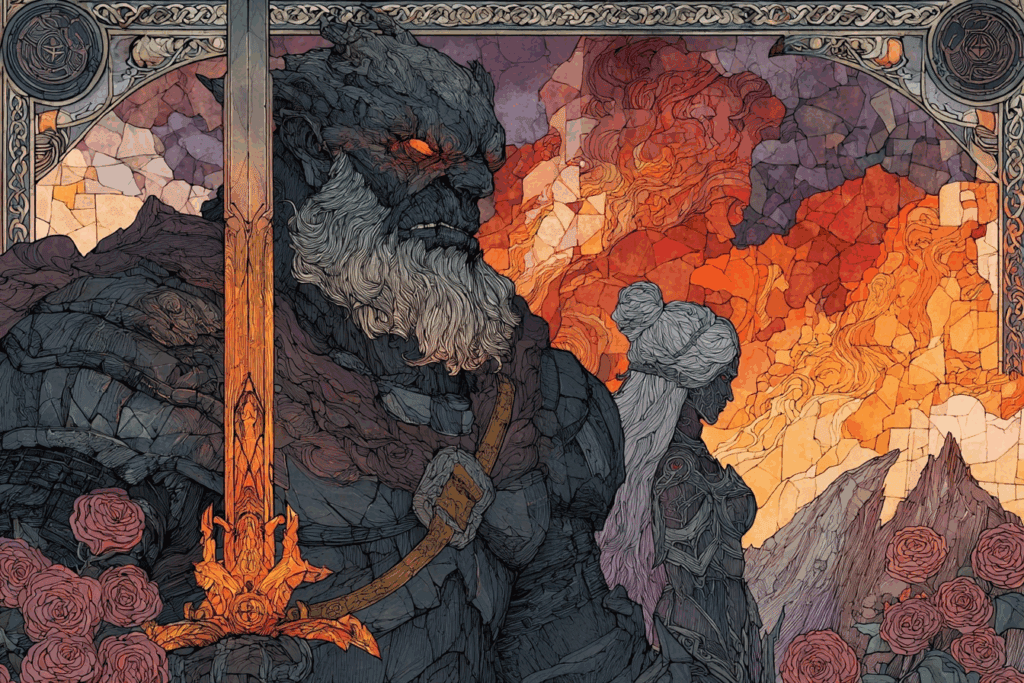In the fiery heart of Norse mythology, no figure embodies destruction and renewal more completely than Surtr.
The very name Surtr, from the Old Norse svartr, meaning “black one”, evokes ash, scorched earth, and primal flame.
Far from being a demonic figure in the Christian sense, Surtr is the ancient fire giant who will ignite the end of the world Ragnarök, not as a villain, but as an essential force of cosmic transformation.
This fearsome figure is one of the most powerful beings in the Norse cosmos, representing the cyclical nature of death and rebirth.

Table of Contents
The Origin of Surtr: Primeval Flame from the South
While studying Teutonic Mythology by Jacob Grimm, we find that Surtr guards the southern realm of fire known as Muspilli or Muspelheim.
This realm of fire and heat is the antithesis to the icy Niflheim and represents one of the earliest cosmological oppositions in Norse cosmology (Grimm, 2004, pp. 808–814).
Surtr is described as “the swarthy one” dwelling at the edge of the world where heaven ends, wielding a flaming sword.
Grimm traces Surtr’s etymology and mythic lineage back to an ancient Indo-European conception of fire beings.
As the ruler of Muspelheim, Surtr is not just a destroyer but a guardian of Muspelheim, a place of both destruction and cosmic importance.
This fire giant from Muspelheim is said to burn the whole world with fire, bringing about the end of the world in an act of fearsome judgment and fiery transformation.
Surtr at Ragnarök: Fire That Ends the Age
Let us now turn to the academic research of Viktor Rydberg, whose Mythology of the Northland explores the cataclysmic final battle.
At Ragnarök, Surtr leads the fire giants from Muspelheim across the Bifröst bridge with his army of fire.
He carries a flaming sword and is said to set the world ablaze (Rydberg, 2003, p. 405). This battle marks the pivotal role Surtr plays as both destroyer and purifier.
In the final battle, Surtr confronts and kills the god Freyr, who appears without his magical sword.
This defeat is more than mythic combat, it represents the symbolic clash between growth and destruction.
Freyr, god of peace, fertility, and seasonal cycles, falls to the fire giant in Norse mythology who represents the power of fire and the volcanic renewal of the earth.
The fire giant Surtr is often associated with fire and volcanic eruption, and this imagery underlines his role as a force of transformation in Norse mythology.

The Flaming Sword and the Giant’s Power
In the academic writings of John McKinnell, we find that Surtr’s weapon, the flaming sword, is no mere accessory.
It is an elemental force. In Myths, Legends, and Heroes, McKinnell notes how Surtr’s flaming sword is a symbol of the end times, used to burn Asgard and Midgard during the events of Ragnarök (McKinnell, 2005, pp. 111–112).
This fire giant in Norse mythology is said to wield this sword with devastating impact, leading the charge that will defeat all the gods.
The weapon’s symbolism is manifold. It represents judgment, transformation, and the burning away of the old world to make room for the new.
The fire and heat it brings are metaphors for renewal through destruction.
In this way, Surtr embodies the cyclical death and rebirth that is central to the Norse view of the cosmos.

Surtr and Christian Influence: Devil or Destroyer?
In The End of the World in Scandinavian Mythology, Anders Hultgård provides critical insight into how the Christianization of the Viking age influenced the depiction of Surtr.
While early texts like the Poetic Edda and Prose Edda depict Surtr as a cosmic force of fire and balance, later Christian readings made him resemble the devil, a bringer of death rather than a necessary agent of renewal (Hultgård, 2007, pp. 41–43).
Despite this transformation, Surtr retains his identity as a fire giant and destroyer. His role in Norse mythology is far more complex than that of a villain.
He is a fearsome figure who must bring about the world’s end so that a new, purified one can emerge.
The association with fire and volcano suggests he may have been inspired by the volcanic geography of Iceland, further rooting him in the natural world as a mythological expression of its raw power.
Surtr and Sinmara: The Fiery Pair
Let us now examine the giantess Sinmara, who is occasionally described as Surtr’s consort in later Norse texts.
Although her role is not well defined, Sinmara is a named figure who may represent death, mystery, or the shadow side of fire’s illumination.
As Viktor Rydberg writes , in some traditions, she guards the weapon that Surtr must wield, linking her intimately to the final battle and to Surtr’s role in Ragnarök.
The pairing of Surtr and Sinmara deepens the symbolism of fire in Norse mythology. As god of war Freyr is slain by the fiery sword, it is Sinmara who ensures Surtr’s readiness.
The goddess like figure named Sinmara plays a silent but significant part in the events of Ragnarök and reflects the myth’s broader themes of darkness, judgment, and necessary destruction (Rydberg, 2003).

Surtr in Comparative Mythology: Jötunn, Surtur, and Beyond
Studying The Religion of the Teutons by Pierre Daniel Chantepie de la Saussaye reveals the broader role of giants or jötnar in Norse mythology.
Surtr, a jötunn or fire giant, is part of this ancient race that stands in contrast to the Æsir and Vanir gods.
He is not unique in being a destroyer but he is certainly the most prominent among the fire giants.
The role of Surtr as destroyer is paralleled by figures like Ymir, and later theological interpretations link him with Surtur, a possible Latinized form used by medieval scribes (Chantepie, 1902, pp. 253–256).
Unlike Thor or Odin who are often considered protectors of order, Surtr is destined to bring that order to an end.
He represents chaos not for its own sake but to reestablish balance. Surtr in Norse mythology is thus the giant who must burn the whole world with fire so that it can be reborn.
Reclaiming Surtr’s Role in Norse Mythology
Surtr is often misunderstood in modern retellings. He is not merely a villain but a central figure in Norse cosmology and mythological structure.
His appearance at Ragnarök is not a surprise attack but a foretold climax rooted in the very foundations of the world.
As Snorri Sturluson recorded in the Prose Edda, the fire giant Surtr is said to rise from the realm of Muspelheim, cross Bifröst, and lead the final battle against the Æsir and Vanir.
The Norse gods fall but not without meaning. In their demise, the world is reshaped. This is the essence of the Norse belief in the cycle of creation and destruction.
The cosmos ends, yes, but it is reborn shining and green.
Surtr’s role in Norse mythology is to ensure that the slate is wiped clean. In this way, Surtr is not a villain but the god of endings and the guardian of transformation.
Surtr, Fire, and the Viking Worldview
Based on reviewing literary sources for Surtr also known as Surt or Surtur, we find that he is one of the most fascinating and complex figures in Norse mythology.
He is the fire giant from Muspelheim who will wield his flaming sword to bring about the end of the world. He is the destroyer and the cleanser, the bringer of death and the herald of rebirth.
From the fiery realm of Muspelheim to the battlefield of Ragnarök, Surtr stands as a giant of Norse mythology whose myth continues to burn brightly in the imagination.
Whether viewed as a volcanic metaphor, a symbol of cosmic justice, or the ultimate god of war, Surtr’s mythic power is undeniable.
As we reflect on his role in Norse tradition, we see not a monster but a mythological force, a powerful agent and a mystical being whose flames illuminate the path to renewal.
References
- Grimm, J. (2004). Teutonic Mythology. Dover Publications. (pp. 808–814).
- Rydberg, V. (2003). The Mythology of the Northland. Kessinger Publishing. (Original work was first published in 1886).
- Hultgård, A. (2007). The End of the World in Scandinavian Mythology. Collegium Medievale, Vol. 20.
- Chantepie de la Saussaye, P. D. (1902). The Religion of the Teutons. Ginn & Co.
- McKinnell, J. (2005). Myths, Legends, and Heroes: Essays on Old Norse and Old English Literature. University of Toronto Press.

